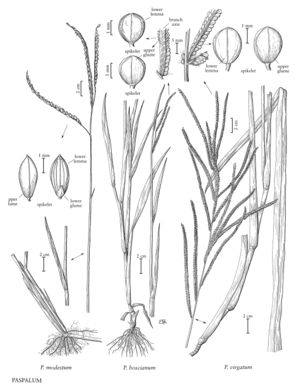Difference between revisions of "Paspalum virgatum"
FNA>Volume Importer |
imported>Volume Importer |
||
| (7 intermediate revisions by 2 users not shown) | |||
| Line 4: | Line 4: | ||
|publications= | |publications= | ||
|common_names=Talquezal | |common_names=Talquezal | ||
| + | |special_status={{Treatment/ID/Special_status | ||
| + | |code=I | ||
| + | |label=Introduced | ||
| + | }} | ||
|basionyms= | |basionyms= | ||
|synonyms= | |synonyms= | ||
| Line 26: | Line 30: | ||
-->{{#Taxon: | -->{{#Taxon: | ||
name=Paspalum virgatum | name=Paspalum virgatum | ||
| − | |||
|authority=L. | |authority=L. | ||
|rank=species | |rank=species | ||
| Line 33: | Line 36: | ||
|basionyms= | |basionyms= | ||
|family=Poaceae | |family=Poaceae | ||
| + | |illustrator=Linda A. Vorobik;Cindy Roché | ||
| + | |illustration copyright=Utah State University | ||
|distribution=Puerto Rico;Virgin Islands;Ala.;Ga.;Tex. | |distribution=Puerto Rico;Virgin Islands;Ala.;Ga.;Tex. | ||
|reference=None | |reference=None | ||
|publication title= | |publication title= | ||
|publication year= | |publication year= | ||
| − | |special status= | + | |special status=Introduced |
| − | |source xml=https:// | + | |source xml=https://bitbucket.org/aafc-mbb/fna-data-curation/src/200273ad09963decb8fc72550212de541d86569d/coarse_grained_fna_xml/V25/V25_1461.xml |
|subfamily=Poaceae subfam. Panicoideae | |subfamily=Poaceae subfam. Panicoideae | ||
|tribe=Poaceae tribe Paniceae | |tribe=Poaceae tribe Paniceae | ||
Latest revision as of 17:57, 11 May 2021
Plants perennial; cespitose. Culms 100-200 cm, stout, erect; nodes glabrous. Sheaths pubescent; ligules 1.9-2.2 mm, brown; blades 30-90 cm long, 1-3 cm wide, flat, glabrous, pubescent behind the ligules. Panicles terminal, with 10-20 racemosely arranged branches; branches 3-15 cm, spreading to diverging; branch axes 1-1.7 mm wide, winged, wings narrower than the central section, terminating in a spikelet. Spikelets 2.2-3.2 mm long, 1.8-2.4 mm wide, paired, appressed to or diverging from the branch axes, obovate, brown. Lower glumes absent; upper glumes and lower lemmas glabrous or variously short pubescent, 5-veined, margins entire; upper florets 2.5-2.7 mm, brown. 2n = 36, 40, 54, 80.
Distribution
Puerto Rico, Virgin Islands, Ala., Ga., Tex.
Discussion
Paspalum virgatum is native from Mexico to South America. It has been introduced to the southeastern United States, where it grows primarily in disturbed areas and cultivated fields.
Selected References
None.
